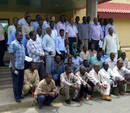News

National Forest Inventories are a very important pillar for national forest monitoring systems. They provide basic data on the carbon stocks of forests and trees, as well as providing reliable data for measurement of uncertainties related to deforestation and forest degradation.
From July 25 to 27 2017, experts from ten countries in the Amazon and Mesoamerican regions met in the Amazonian city of Manaus, Brazil to share their best practices and progress in developing National Forest Inventories. The event was organized by the Brazilian Forest Service in close collaboration with FAO through the UN-REDD Programme, and the Tropical Agriculture Research and...

With the support of the Central African Forest Initiative (CAFI) and the UN-REDD Programme, the government of the Democratic Republic of Congo (DRC), the Japan International Cooperation Agency (JICA), and FAO together delivered capacity development training for the DRC National Forest Inventory (NFI) from 16 to 28 July 2017. The training in the Luki Biosphere Reserve at the National Agricultural Research Institute (INERA), strengthened the capacities of 49 participants including Directorate of Forest Inventories and Management (DIAF) engineers, technicians and botanists, and NFI implementing partners in the provinces.

Work is underway in Sudan to help the country reduce its greenhouse gas emissions and pursue low-carbon development through creation and implementation of National Forest Inventory (NFI) as a necessary step towards REDD+ readiness.
Sudanese NFI teams have been in the field in North Kordofan State since May 2017, collecting data under a Technical Assistance Agreement signed between the Government of Sudan and FAO late last year. Under that agreement, FAO is supporting Sudan’s Forests National Corporation (FNC), part of the country’s Ministry of Agriculture and Forestry, to also design and implement a measuring, reporting and verification (MRV) system for REDD+....

Accurate and consistent information on forest area and forest area change is a requirement if a country is to access results-based payments for its REDD+ activities. The goal is to obtain as accurate area estimates as possible but what is ‘as accurate as possible’?
‘What is the level of precision a country can achieve when estimating its area of forest and how the area is increasing or decreasing over time’?
These questions can help clarifying the complex issue of area estimation but do not have straight-forward answers. The accuracy depends on many factors which experts from FAO, FCPF, GFOI, USFS, JRC of EC,...

Most developing countries participating in the REDD+ process and willing to access Result Based Payments (RBP) are now in transition from their readiness phase to implementation of specific actions and measures. Most of these countries have developed and/or strengthened their National Forest Monitoring Systems (NFMS) which are also moving towards the implementation phase and towards the monitoring of the results of mitigation actions. However, many countries still face multiple challenges in accessing the information and data they need to make their NFMS sustainable in the long term.

